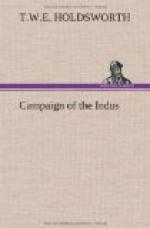manner by parties thrown forward by Major-General
Sir Willoughby Cotton, of the 16th and 48th Bengal
Native Infantry, and her Majesty’s 13th Light
Infantry, under Brigadier Sale. I ordered forward
three troops of horse artillery, the camel battery,
and one foot battery, to open upon the citadel and
fortress, by throwing shrapnel shells, which was done
in a masterly style under the direction of Brigadier
Stephenson. My object in this was to make the
enemy shew their strength in guns, and in other respects,
which completely succeeded, and our shells must have
done great execution, and occasioned great consternation.
Being perfectly satisfied on the point of their strength
in the course of half an hour, I ordered the fire
to cease, and placed the troops in bivouac. A
close reconnoissance of the place all around was then
undertaken by Captain Thomson, the chief engineer,
and Captain Peat, of the Bombay Engineers, accompanied
by Major Garden, the Deputy Quartermaster-General of
the Bombay army, supported by a strong party of her
Majesty’s 16th Lancers, and one from her Majesty’s
18th Light Infantry. On this party a steady fire
was kept up, and some casualties occurred. Captain
Thomson’s report was very clear, he found the
fortifications equally strong all round; and, as my
own opinion coincided with him, I did not hesitate
a moment as to the manner in which our approach and
attack upon the place should be made. Notwithstanding
the march the troops had performed in the morning,
and then having been a considerable time engaged with
the enemy, I ordered the whole to move across the
river (which runs close under the fort wall) in columns,
to the right and left of the town, and they were placed
in opposition on the north side on more commanding
ground, and securing the Cabool road. I had information
that a night attack upon the camp was intended from
without. Mahomed Ubzul Khan, the eldest son of
Dost Mahomed Khan, had been sent by his father with
a strong body of troops from Cabool to the brother’s
assistance at Ghuzni, and was encamped outside the
walls, but abandoned his position on our approach,
keeping, however, at the distance of a few miles from
us. The two rebel chiefs of the Ghiljee tribe,
men of great influence—viz., Abdool Rhuman
and Gool Mahomed Khan, had joined him with 1500 horse,
and also a body of about 3000 Ghazees from Zeimat,
under a mixture of chiefs and mollahs, carrying banners,
and who had been assembled on the cry of a religious
war. In short, we were in all directions surrounded
by enemies. These last actually came down the
hills on the 22nd, and attacked the part of the camp
occupied by his Majesty Shah Shooja and his own troops,
but were driven back with considerable loss, and banners
taken.




